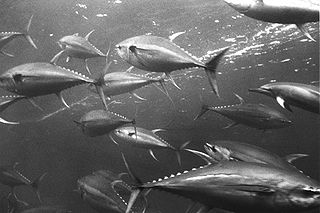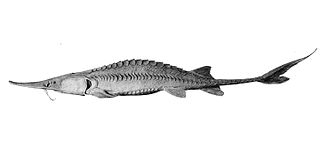
Mackerel is a common name applied to a number of different species of pelagic fish, mostly from the family Scombridae. They are found in both temperate and tropical seas, mostly living along the coast or offshore in the oceanic environment.

The Scombridae family of the mackerels, tunas, and bonitos includes many of the most important and familiar food fishes. The family consists of 51 species in 15 genera and two subfamilies. All species are in the subfamily Scombrinae, except the butterfly kingfish, which is the sole member of subfamily Gasterochismatinae.

Sturgeon is the common name for the 27 species of fish belonging to the family Acipenseridae. Their evolution dates back to the Triassic some 245 to 208 million years ago. The family is grouped into four genera: Acipenser, Huso, Scaphirhynchus and Pseudoscaphirhynchus. Four species may now be extinct. Two closely related species, Polyodon spathula and Psephurus gladius are of the same order, Acipenseriformes, but are in the family Polyodontidae and are not considered to be "true" sturgeons. Both sturgeons and paddlefish have been referred to as "primitive fishes" because their morphological characteristics have remained relatively unchanged since the earliest fossil record. Sturgeons are native to subtropical, temperate and sub-Arctic rivers, lakes and coastlines of Eurasia and North America.

Mahseer is the common name used for the genera Tor, Neolissochilus, and Naziritor in the family Cyprinidae (carps). The name is, however, more often restricted to members of the genus Tor. The range of these fish is from Malaysia, Indonesia, and across southern Asia including the Indian Peninsula and Pakistan. They are commercially important game fish, as well as highly esteemed food fish. Mahseer fetch high market price, and are potential candidate species for aquaculture. Several of the larger species have suffered severe declines, and are now considered threatened due to pollution, habitat loss, and overfishing.

"Sardine" and "pilchard" are common names used to refer to various small, oily fish in the herring family Clupeidae. The term "sardine" was first used in English during the early 15th century and may come from the Mediterranean island of Sardinia, around which sardines were once abundant.

The Squaliformes are an order of sharks that includes about 126 species in seven families.

The Lamniformes are an order of sharks commonly known as mackerel sharks. It includes some of the most familiar species of sharks, such as the great white and extinct megalodon, as well as more unusual representatives, such as the goblin shark and megamouth shark.

The Gonostomatidae are a family of mesopelagic marine fish, commonly named bristlemouths, lightfishes, or anglemouths. It is a relatively small family, containing only eight known genera and 32 species. However, bristlemouths make up for their lack of diversity with numbers: Cyclothone, with 12 species, is thought to be the most abundant vertebrate genus in the world, numbering in the hundreds of trillions to quadrillions.
Melanonus is a genus of gadiform fishes containing just two species of cod-like marine fishes. This is the only genus in the family Melanonidae.

The cornetfishes or flutemouths are a small family, the Fistulariidae, of extremely elongated fishes in the order Syngnathiformes. The family consists of a single genus, Fistularia, with four species, found worldwide in tropical and subtropical marine environments.

The duckbill eels or witch eels are a family, Nettastomatidae, of eels. The name is from Greek netta meaning "duck" and stoma meaning "mouth".

The trumpetfishes are three species of highly specialized, tubular-elongated marine fishes in the genus Aulostomus, of the monogeneric family Aulostomidae. The trumpetfishes are members of the order Syngnathiformes, together with the seahorses and the similarly built, closely related cornetfishes.

Thunnus is a genus of ocean-dwelling, ray-finned bony fish from the Scombridae (mackerel) family. More specifically, Thunnus is one of five genera which make up the Thunnini tribe – a tribe that is collectively known as the tunas. Also called the true tunas or real tunas, Thunnus consists of eight species of tuna, divided into two subgenera. The word Thunnus is the Middle Latin form of the Ancient Greek: θύννος, translit. (thýnnos), lit. 'tunny-fish' – which is in turn derived from θύνω (thynō), "to rush; to dart". The first written use of the word was by Homer.

Liza is a genus of mullets from the family Mugilidae. Recent work has suggested that the genus is paraphyletic and its species should be placed in the resurrected genus Planiliza while others should be classified in the traditional genera Mugil and Chelon. Liza is derived from the Spanish word for a grey mullet.

Crenimugil is a genus of mullets found in coastal marine waters and rivers in the Indo-Pacific region.

Garra is a genus of fish in the family Cyprinidae. These fish are one example of the "log suckers", sucker-mouthed barbs and other cyprinids commonly kept in aquaria to keep down algae. The doctor fish of Anatolia and the Middle East belongs in this genus. The majority of the more than 140 species of garras are native to Asia, but about one-fifth of the species are from Africa.

Scaphirhynchus is a genus of sturgeons native to the United States of America. All species in this genus are considered to be threatened. The pallid sturgeon is Endangered and the Alabama sturgeon is Critically Endangered.

Zaniolepis is a genus of scorpaeniform fish native to the eastern Pacific Ocean. Z. frenata is known to have been a source of food to the Native American inhabitants of San Nicolas Island off the coast of southern California, United States during the Middle Holocene.

The Catostomidae are the suckers of the order Cypriniformes, with about 78 species in this family of freshwater fishes. The Catostomidae are primarily native to North America, but Catostomus catostomus is found in both North America and Russia, and Myxocyprinus asiaticus is from China. They are not usually fished recreationally; they are not highly prized in North America for their flesh, although they are a fairly popular target with spear fisherman, and in some areas, such as the Ozarks, they are a common food fish.

Caesioperca is a genus of ray-finned fish in the sub-family Anthiadinae in the sea bass family Serranidae. It contains just two species, found in the ocean off Southern Australia and New Zealand.



















